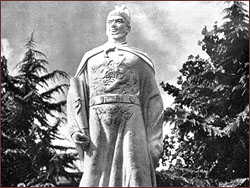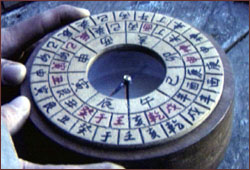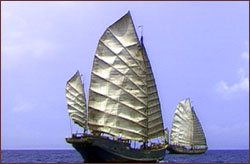 |
 |
|  Zheng He (1371-1433), the great Ming navigator.
Zheng He (1371-1433), the great Ming navigator.
|
Ancient Chinese Explorers
Part 2 | Back to part 1
Exploits of the eunuch admiral
Zheng He commemorated his adventures on a stone pillar discovered in Fujian province
in the 1930s. His mission, according to the pillar, was to flaunt the might of
Chinese power and collect tribute from the "barbarians from beyond the seas."
On his first trip, leading more than 60 massive galleons, Zheng He visited what
would later become Vietnam and reached the port of Calicut, India. On his
return, he battled pirates and established massive warehouses in the Straits of
Malacca for sorting all the goods accumulated on this and subsequent voyages.
While voyaging to India, the ships encountered a ferocious hurricane. Zheng He
prayed to the Taoist Goddess known as the Celestial Spouse. In response, a
"divine light" shone at the tips of the mast, and the storm subsided. This
heavenly sign—perhaps the static electrical phenomenon known as St. Elmo's
fire—led Zheng He to believe that his missions were under special divine
protection.
The emperor launched Zheng He's fourth and most ambitious voyage in January
1414. Its destination was Hormuz on the Persian Gulf, where artisans strung
together exquisite pearls and merchants dealt in precious stones and metals.
While Zheng He lingered in the city to amass treasure for the emperor, another
branch of the fleet sailed to the kingdom of Bengal in present-day Bangladesh.
Here the travelers saw a giraffe that the east African potentate of Malindi had
presented to the Bengal ruler. The Chinese persuaded their hosts to part with
the giraffe as a gift to the emperor and to procure another like it from
Africa. When the giraffe arrived at the court in Nanjing in 1415, the emperor's
philosophers identified it, despite its pair of horns, as the fabled
chi'i-lin or unicorn, an animal associated with an age of exceptional
peace and prosperity. As the fleet's merchants laid treasures from Arabia and
India at the feet of the emperor, this omen must surely have seemed
fitting.
 To navigate throughout the Indian Ocean, Zheng
He would have made use of the magnetic compass, invented in China during the
Song dynasty.
To navigate throughout the Indian Ocean, Zheng
He would have made use of the magnetic compass, invented in China during the
Song dynasty.
|
|
The initial diplomatic contact with Malindi now encouraged Zheng He to plan a
direct trading voyage to eastern Africa. Landing at Somalia on the coast, he
found himself offered such exotic items as "dragon saliva, incense, and golden
amber." But even these substances paled before the extraordinary beasts that
were loaded on board his ships. Lions, leopards, "camel-birds" (ostriches),
"celestial horses" (zebras), and a "celestial stag" (oryx), were shipped back
to the imperial court. Here officials showered congratulations on Zheng He and
bowed low in awe before the divine creatures that accompanied him.
End of an era
Toward
the end of his seventh voyage in 1433, the 62-year-old Zheng He died and was
said to have been buried at sea. Although he had extended the wealth and power
of China over a vast realm and is even today revered as a god in remote parts
of Indonesia, the tide was already turning against foreign ventures.
The conservative Confucian faction now had the upper hand. In its worldview, it
was improper to go abroad while one's parents were still alive. 'Barbarian'
nations were seen as offering little of value to add to the prosperity already
present in the Middle Kingdom.
The renovation of the massive Grand Canal in 1411 offered a quicker and safer
route for transporting grain than along the coast, so the demand for oceangoing
vessels plummeted.
In addition, the threat of a new Mongol invasion drew military investment away
from the expensive maintenance of the treasure fleets. By 1503 the navy had
shrunk to one tenth of its size in the early Ming. The final blow came in 1525
with the order to destroy all the larger classes of ships. China was now set on
its centuries-long course of xenophobic isolation.
|  Impressive as they are, Chinese junks today are but pale shadows of medieval
Chinese ships.
Impressive as they are, Chinese junks today are but pale shadows of medieval
Chinese ships.
|
Historians can only speculate on how differently world history might have
turned out had the Ming emperors pursued a vigorous colonial policy. As it is,
porcelain shards washed up on the beaches of east Africa and old men's
folktales of shipwreck are among the few tangible relics of China's epic
voyages of adventure.
Evan Hadingham is NOVA's Senior Science Editor.
Further Reading
When China Ruled the Seas. By Louise Levathes. New York: Oxford University
Press, 1994.
Archaeology and the Social History of Ships. By Richard A. Gould. New
York: Cambridge University Press, 2000.
"The Rise and Fall of 15th Century Seapower." By Michael L. Bosworth. See
www.cronab.demon.co.uk/china.htm.
"1492: The Prequel." By Nicholas D. Kristof. The New York Times, June 6,
1999.
"Chinese Maritime History and Nautical Archaeology: Where Have All the Ships
Gone?" By Hans Van Tilburg. See
www.mm.wa.gov.au/Museum/aima/bulletins/Bulletin18_2/China.html
Photos: (1) Pierre Corrade; (2-4) Courtesy of Instructional Resources Corporation, http://www.historypictures.com.
On China's China |
Ancient Chinese Explorers
Asia's Undersea Archeology |
Date the Dish |
Resources
Transcript |
Site Map |
Sultan's Lost Treasure Home
Editor's Picks |
Previous Sites |
Join Us/E-mail |
TV/Web Schedule
About NOVA |
Teachers |
Site Map |
Shop |
Jobs |
Search |
To print
PBS Online |
NOVA Online |
WGBH
© | Updated January 2001
|
|
|